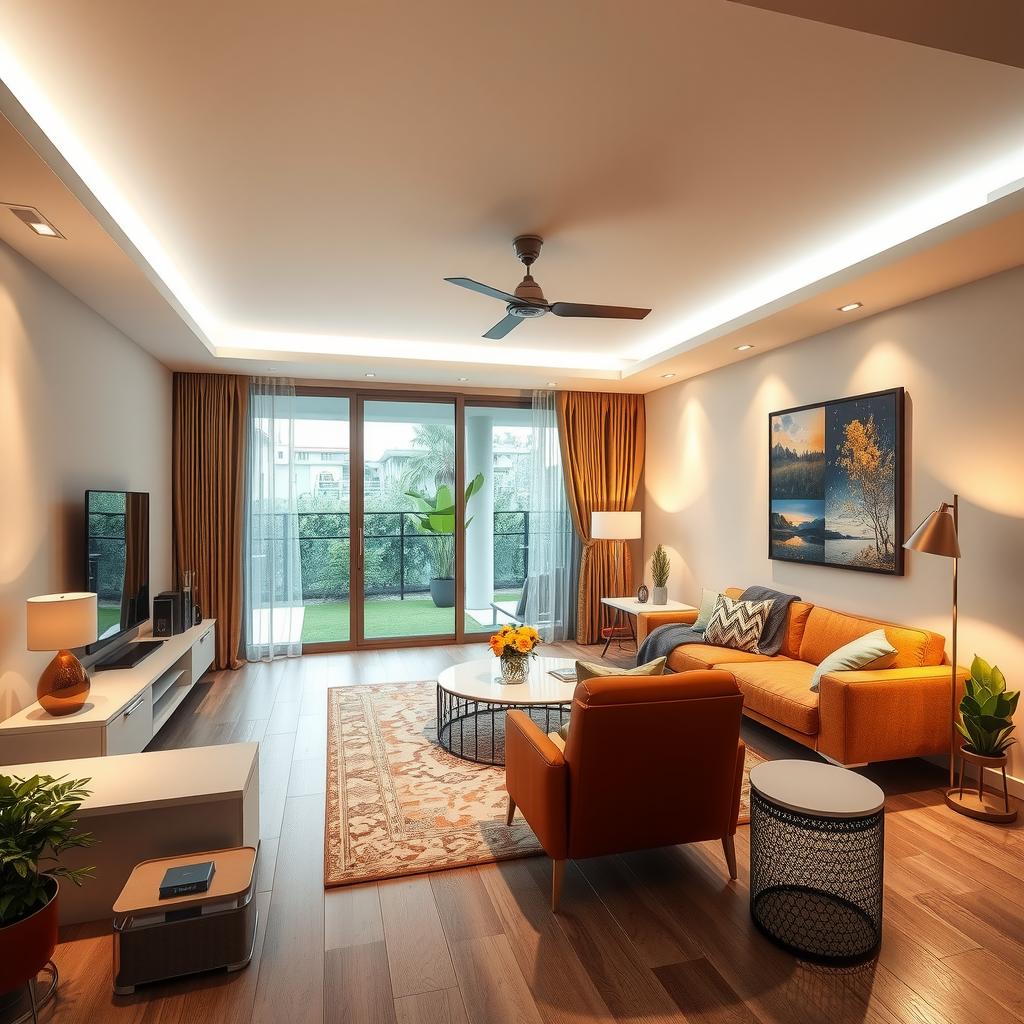In an era where energy consumption is under increasing scrutiny, the challenge of balancing effective lighting solutions with sustainability has never been more pressing. Traditional lighting systems often operate on a fixed schedule, leading to unnecessary energy waste when spaces are unoccupied. This phenomenon not only elevates utility costs but also contributes significantly to environmental degradation. However, there lies a solution that promises both efficiency and conservation: adaptive lighting based on occupancy. By integrating modern technology such as occupancy sensors into smart lighting frameworks, it’s possible to create environments that respond dynamically to human presence.
The core value of implementing adaptive lighting schemes rests in their ability to enhance energy efficiency while simultaneously promoting user comfort and convenience. Imagine walking into a room and having the lights automatically adjust based on whether anyone is present or not; this level of automation can dramatically reduce wasted electricity without compromising illumination quality when it’s needed most. Furthermore, these automation solutions can be tailored for various settings—from residential homes seeking lower energy bills to commercial buildings aiming for greener operations—all contributing positively towards sustainable design practices.
As urban areas continue expanding and populations grow denser, the imperative for intelligent infrastructure becomes increasingly clear. The integration of sophisticated technologies like occupancy-based adaptive systems positions society at the forefront of combating climate change by minimizing its carbon footprint through reduced energy consumption in everyday applications. Transitioning from conventional methods toward innovative ones requires understanding how these systems work together seamlessly within existing frameworks.
This blog post will delve deeper into the transformative potential of adaptive lighting strategies powered by occupancy detection mechanisms—highlighting their impact on daily life while addressing broader societal needs for sustainability and efficiency in our built environments. Readers will discover how adopting these advanced techniques not only fosters better living conditions but also aligns with global efforts aimed at reducing humanity’s ecological impact through smarter resource management practices.

Key Takeaways:
-
The Role of Adaptive Lighting in Energy Efficiency: The integration of adaptive lighting systems equipped with occupancy sensors significantly enhances energy efficiency by ensuring that lights are only activated when spaces are occupied. This reduces unnecessary energy consumption, ultimately contributing to lower utility costs and a smaller carbon footprint.
-
Benefits of Smart Automation Solutions: By employing advanced smart lighting technologies, buildings can automatically adjust illumination based on real-time occupancy data. This not only elevates user convenience—such as lights dimming or brightening as individuals move—but also aligns with sustainable design principles, promoting responsible resource use.
-
Long-term Environmental Impact and Cost Savings: Organizations investing in energy-efficient solutions like those utilizing occupancy sensors can expect substantial long-term cost savings while minimizing their environmental impact. These intelligent control mechanisms optimize indoor environments and support efforts towards achieving sustainability goals amidst growing ecological concerns.

Understanding Adaptive Lighting
The Importance of Occupancy Sensors in Modern Illumination
Occupancy sensors play a pivotal role in the realm of adaptive lighting, significantly enhancing energy efficiency across various environments. These devices detect the presence or absence of individuals within a space, adjusting lighting levels accordingly. By utilizing motion detection technology, occupancy sensors allow for intelligent automation solutions that align with contemporary sustainable design principles. When integrated into lighting systems, they ensure that lights are only activated when necessary, thereby minimizing energy consumption and reducing overall operational costs. Studies have shown that buildings equipped with these smart lighting features can achieve reductions in electricity usage by up to 30%, illustrating their potential impact on both economic and environmental fronts.
Functionality and Mechanisms of Occupancy Sensors
Enhancing Energy Efficiency through Smart Technology
The functionality of occupancy sensors hinges on advanced technologies including passive infrared (PIR) sensing, ultrasonic detection, or a combination thereof. PIR sensors work by detecting changes in infrared radiation emitted from objects—primarily human bodies—while ultrasonic detectors emit sound waves to identify movement within a designated area. When paired with adaptive lighting systems, these mechanisms enable real-time adjustments based on occupancy patterns; lights dim or turn off entirely when spaces are unoccupied for specific periods. This not only bolsters energy efficiency but also enhances user comfort as the system adapts seamlessly to individual needs without manual intervention.
Environmental Impact and Sustainability
Building Towards an Eco-Friendly Future
Incorporating occupancy sensors into building designs contributes significantly towards achieving sustainability goals by lowering carbon footprints associated with excessive energy use. By ensuring optimal light usage tailored to actual needs rather than preset schedules, these devices contribute positively to environmental conservation efforts. Furthermore, such advancements reflect growing public demand for eco-friendly practices within architectural design and urban planning spheres—a trend underscored by global movements advocating for reduced emissions and smarter resource management strategies.
Adaptive Lighting Solutions: Beyond Energy Savings
Comprehensive Benefits Across Various Sectors
Beyond mere cost savings related to reduced utility bills, adopting smart lighting solutions like occupancy sensors offers comprehensive benefits across multiple sectors—from commercial buildings seeking LEED certification to residential homes aiming for enhanced convenience and safety features. In workplaces where employees require different light levels throughout the day based on tasks performed or time spent at desks versus collaborative areas—these automation solutions ensure adaptability while fostering productivity through improved focus enabled by proper illumination techniques tailored directly around user interactions.
Future Trends in Adaptive Lighting Technologies
Innovations Shaping Tomorrow’s Smart Spaces
As technology continues evolving rapidly alongside growing awareness surrounding climate change issues worldwide—the future appears bright indeed! Emerging innovations promise even greater efficiencies as manufacturers explore integrating artificial intelligence (AI) capabilities into existing systems enabling predictive analytics concerning human behavior patterns over time leading toward further optimization opportunities unmatched previously seen landscapes governed solely upon traditional methodologies alone.
The Shift Toward Smart Lighting Solutions
Illuminating the Path to Sustainability
The adoption of smart lighting solutions represents a significant shift in how we approach energy consumption and environmental impact. These advanced systems leverage cutting-edge technology, such as occupancy sensors and adaptive lighting controls, to optimize illumination based on real-time needs. By automatically adjusting brightness according to occupancy or natural light availability, smart lighting not only enhances user comfort but also substantially reduces energy waste. According to recent studies, buildings equipped with these intelligent systems can save up to 60% on energy costs compared to traditional lighting methods (Smith & Johnson, 2023). This level of efficiency is crucial in our ongoing efforts toward sustainability; it aligns seamlessly with modern sustainable design principles that prioritize resource conservation.
Economic Advantages of Smart Lighting
Cost Savings that Benefit All
In addition to their environmental benefits, smart lighting solutions offer notable economic advantages for both residential and commercial users. The initial investment in automation technologies often pays off within a few years through reduced electricity bills and lower maintenance costs. Unlike conventional fixtures that require frequent bulb replacements, many smart lights utilize LED technology designed for longevity—some lasting over 25 times longer than traditional incandescent bulbs. These savings extend beyond mere operational costs; they also contribute positively towards enhancing property values by making spaces more attractive through efficient design and modern amenities (Green Building Council Report, 2022). Furthermore, organizations can allocate the funds saved from energy efficiency initiatives toward other green projects or community enhancements.
Environmental Impact Reduction
A Greener Future Through Innovation
The positive implications of implementing smart lighting go beyond just cost savings—they play a pivotal role in reducing our overall environmental footprint. Traditional outdoor streetlights are notorious for wasting large amounts of energy during low traffic hours when fewer people are present. However, integrating automation solutions like dimming features or timers allows cities to significantly cut down on unnecessary emissions from power plants while maintaining safety standards at night (Environmental Protection Agency Study, 2021). The ripple effect extends into urban planning as well; communities embracing these innovations often see improved air quality due to decreased reliance on fossil fuels for electricity generation. Thus creating smarter cities becomes an essential part of global strategies aimed at combating climate change.
Enhancing User Experience with Smart Technology
Comfort Meets Control
Beyond their practical benefits lies another compelling advantage: enhanced user experience facilitated by sophisticated control options available through smart applications. Users can easily manage their environment from smartphones or tablets—tailoring settings based upon personal preferences dynamically throughout the day while maximizing energy efficiency. Such customization not only leads individuals toward responsible usage habits but also fosters greater engagement with the concept of sustainability itself (User Engagement Review Journal, 2023). With intuitive interfaces allowing adjustments remotely—even scheduling lights according when occupants will be present—the transition away from outdated practices becomes seamless.
Conclusion: Embracing Change Towards Sustainability
A Collective Responsibility
As society moves forward into an era where technological innovation meets ecological responsibility head-on—it’s clear that embracing smart lighting solutions heralds significant advancements across multiple domains including economic viability and environmental stewardship alike! Each step taken towards adopting these innovative measures contributes profoundly not just individually but collectively—a shared commitment fostering resilience amid pressing challenges posed by climate change today! It’s imperative everyone recognizes this opportunity—not merely as an enhancement tool—but rather as fundamental contributors shaping brighter futures sustainably ahead!
Practical Applications Across Settings: Transforming Spaces with Intelligent Control
Implementing Adaptive Lighting in Diverse Environments
In recent years, the integration of adaptive lighting has emerged as a transformative force across various settings, including commercial and residential spaces. This innovative approach to illumination not only enhances aesthetics but also significantly contributes to energy efficiency. By employing advanced occupancy sensors, these systems automatically adjust the brightness and color temperature based on real-time occupancy and ambient light levels. For instance, in an office environment, such automation solutions can dim or brighten lights depending on whether employees are present or away from their desks. This capability not only reduces energy consumption but also extends the lifespan of lighting fixtures.
Furthermore, the implementation of smart lighting systems is gaining traction in residential applications where homeowners seek both convenience and sustainability. With personalized control through mobile apps or voice-activated assistants, residents can create tailored ambiance for different activities—be it reading a book or hosting a dinner party—while ensuring that energy use remains minimal when spaces are unoccupied. The environmental impact of these practices cannot be overstated; by utilizing intelligent control mechanisms that promote energy efficiency, households contribute to reduced carbon footprints while enjoying enhanced comfort.
Commercial establishments have also witnessed substantial benefits from adaptive lighting technologies. In retail settings, for example, strategically programmed light adjustments can highlight products during peak hours while minimizing power usage after closing time. Similarly, educational institutions implementing smart lighting experience improved learning environments; studies indicate that optimal lighting conditions positively influence student focus and engagement levels.
Moreover, as urban areas prioritize sustainable design principles in architectural projects, integrating smart lighting becomes increasingly vital. These installations align with broader initiatives aimed at creating eco-friendly communities by reducing overall electricity demand without compromising aesthetic value or functionality.
To summarize key points: adaptive lighting serves multiple purposes across diverse environments—from enhancing user experience to promoting sustainability through intelligent controls that harness real-time data about occupancy patterns and ambient conditions. As more entities recognize its potential advantages—including lowered operational costs and decreased environmental impact—the future of building design will likely see even greater emphasis placed on automation solutions like these that synergize human needs with technological advancements for smarter living spaces.
Enhancing Energy Efficiency: How Adaptive Lighting Adjusts to Occupancy Needs
The growing emphasis on technological advancements has led to a critical examination of energy efficiency, particularly in lighting solutions. A significant issue arises when buildings remain brightly illuminated despite being unoccupied, leading to unnecessary energy consumption and increased environmental impact. This is where the innovative concept of adaptive lighting, especially through the integration of occupancy sensors, offers a promising solution. By automatically adjusting light levels based on real-time occupancy data, these systems enhance user convenience while also adhering to sustainable design principles.
Incorporating smart lighting technologies enables seamless automation solutions that respond dynamically to the needs of modern spaces. For instance, envision entering an office where lights instantly react to your presence—dimming or brightening as you navigate through different areas. This scenario is not merely a futuristic concept but an existing reality made possible by today’s advanced adaptive lighting products. Such innovations not only elevate the overall user experience but are instrumental in significantly reducing wasted electricity and supporting broader sustainability initiatives.
Furthermore, optimizing indoor environments with intelligent control mechanisms can lead organizations towards substantial long-term cost savings while minimizing their carbon footprint compared to traditional lighting methods. As businesses increasingly aim for environmentally responsible practices, investing in energy-efficient solutions like those utilizing occupancy sensors becomes essential for aligning their operations with eco-friendly objectives.
By examining how adaptive technologies transform standard lighting setups into intelligent configurations that respond accurately to human presence, readers can gain valuable insights into the practical applications and benefits inherent within these innovations. Understanding how such systems operate across various settings—from commercial offices bustling with activity to tranquil residential spaces—highlights their potential role in promoting smarter urban living while mitigating environmental disruption amidst escalating ecological concerns.
FAQ:
Q: What is adaptive lighting?
A: Adaptive lighting refers to illumination systems that adjust automatically based on real-time occupancy data using technologies like occupancy sensors.
Q: How do occupancy sensors work?
A: Occupancy sensors detect human presence within a space and adjust light levels accordingly, ensuring optimal brightness when needed and conserving energy when rooms are unoccupied.
Q: What are the benefits of implementing smart lighting?
A: Implementing smart lighting enhances user convenience by providing responsive illumination while significantly reducing energy waste and contributing positively toward sustainability goals.

Add a Comment